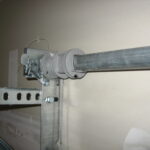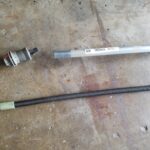If your garage door won’t open, it probably has a broken spring. All garage doors are lifted by some type of spring system that counterbalances the weight of the door. Over the past 20 years many of the garage doors installed on newly built homes have come with the TorqueMaster system.


The TorqueMaster is an alternative to the standard torsion spring system. It is used on many garage doors manufactured by Wayne Dalton. TorqueMaster systems are less expensive (hence the popularity with builders) than a quality standard torsion system, but you get what you pay for. Or, to be accurate, you get what the builder pays for.
When the spring inside your TorqueMaster system breaks, your door won’t open. Because the spring is internal to the horizontal tube that you see above your door, you can’t tell by looking at it. With the door on the ground, pull the manual release to disconnect your door from the opener and attempt to lift the door. If it feels heavy like it would just drop to the ground if you let go, then you have a broken TorqueMaster Spring.
Most garage door companies prefer to convert broken TorqueMaster systems over to standard torsion. In my opinion, this is definitely the way to go, as standard systems are much longer lasting (up to 40,000 cycles compared to only 10,000 or so), smoother operating, and more reliable. If you insist on having it replaced with an identical TorqueMaster, be prepared to wait for another visit as it will probably need to be ordered, whereas most companies carry standard torsion equipment with them on a daily basis.
TorqueMaster systems can also be sneaky dangerous to work on, so don’t go messing around with it. It is common for them to get jammed when they break, resulting in tension that can be suddenly released if you start taking things apart. You can’t replace the springs individually (a whole new tube is required), so it is not worth the risk.
One final note: many TorqueMaster systems are poorly installed. This has nothing to do with the product itself, but the fact that it is most commonly found on new construction doors that builders put up fast and cheap. It’s a good idea to take a close look at the rest of your door and make sure nothing else looks like a problem, and if you have a professional out ask them to double check everything.